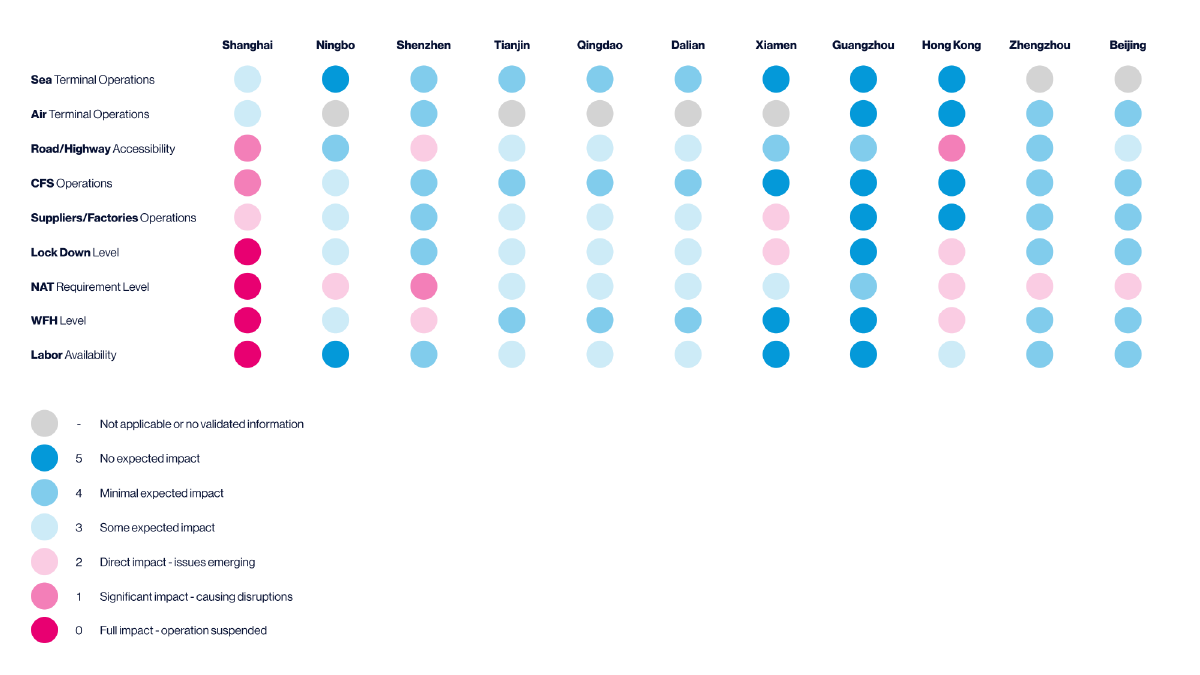At the end of March, the Chinese government’s no-COVID policy had led to new lockdowns in China. As a result, the metropolis of Shanghai with its more than 25 million inhabitants was divided into two parts and one part after the other was sealed off. The latest results of mass testing now showed that the number of infections, however, are still at a high level, leading the Chinese government to extend the lockdown indefinitely.
Why is this having an impact in particular on logistics as well? Pudong, for instance, is home to the largest container terminals WGQ and Yangshan as well as the PVG airport. Other major port cities such as Shenzhen and Hong Kong were also in lockdown due to rising COVID-19 numbers. However, in Shenzhen, some restrictions have already been lifted, allowing factories to reopen earlier than planned, in order to mitigate the impact on supply chains.
The lockdowns have already had a wide range of effects on the ports’ operations. For example, many terminals (Hong Kong, among others) could not be supplied or could only be supplied inadequately due to strict restrictions on truck drivers. Furthermore, staff shortages have occurred, such as at the container freight stations in Shenzhen, which has particularly affected cargo operations.
In Shanghai, truck drivers are only allowed to leave or enter the city if they can provide a negative PCR test and a negative nucleic acid test that are no more than 48 hours old. Many port workers simply cannot get to their workplaces from their home areas due to the curfew. Shanghai ports are currently operating, but are expected to be short-staffed, so cargo backlogs are likely to occur.
Background
China is currently dealing with the largest number of COVID-19 cases since the pandemic began. The areas where the number of new infections increased accounted for 22.1% of national gross domestic product (GDP) and 21.4% of retail sales. J.P. Morgan’s latest forecast for 2022 GDP growth now stands at 5.1% as a result of covid infections and the Chinese government’s covid policy-in contrast, the Chinese government publicizes a growth target of 5.5%. Stock markets in China and Hong Kong are currently fluctuating strongly. The investment confidence is rather pessimistic – given the COVID waves in China itself, but also reflecting global geopolitical tensions. The stock markets in China and Hong Kong are also fluctuating strongly as well.
Impact of the Measures Against COVID-19
As in Shenzhen, Hong Kong, and other regions of China (such as the Yangtze Delta), the Shanghai lockdown will also have an impact on global supply chains. So far, it is still unclear when the situation in China may fully return to normal. This also depends, among other things, on whether the Chinese government will at least partially abandon its no-COVID policy.

Truck Transport
The land transportation sector still remains the largest roadblock under the current situation. Trucks loaded with containers are still allowed to drive on the roads, especially the highways. Truck drivers must provide evidence of a negative nucleic acid test in order to pick up and drop off cargo at the terminals. Next to that, the containers must have an Equipment Interchange Receipt (EIR), a document given to the shipper when the containers are delivered to or picked up from the terminal, which lists, among other things, the container number and code of the ship. For truck operations in/from Shanghai, a negative nucleic acid test result of fewer than 48 hours and a negative antigen test result of fewer than 24 hours are required.
Sea Freight
At present, the container ports in Shanghai are still operating. There are no announcements of closure or suspension of operations. However, staff shortages are a possibility, preventing the ports from maintaining full operations. Exports of goods from China are expected to be more affected than imports. The reason behind this is that it would be difficult to supply the ports in Shanghai due to the COVID-19 measures, also the factories would not be able to operate as usual. The reason: The supply of the ports in Shanghai has become difficult due to the COVID-19 measures, in addition, the factories will not be able to work as usual. Therefore, it cannot be guaranteed that scheduled cargo shipments, especially from factories located in Shanghai and the surrounding area, will arrive at the ports on time, and bookings risk being delayed. Shanghai port operations, such as empty container pickup and customs control, are also very likely to be severely impacted in the coming days.
Air Cargo
Various airliners, especially overseas airliners, have canceled multiple flights ex PVG in recent days. Also in this area, trucking is one of the biggest challenges in the operation chain for PVG and alternatives. Terminals (CGO, CSX, CKG, HFE) require truck drivers to have a negative nucleic acid test less than 48 hours old. Other provinces have equally specific requirements for truckers transporting cargo coming from or passing through Shanghai. Air cargo rates from other terminals such as CTU, CGO, CSX, HKH increased as well as a result of the current circumstances.
Container depots
The Chinese government’s COVID-19 policy is also affecting several warehouses and container freight stations. After the temporary closure of several container depots, some of them are now partially back in operation to release empty containers. Overall, efficiency is at a lower level, and backlogs may be piling up at the ports.
Forto can assist you!
We at Forto keep you, our customers, continuously informed about the developments in China and inform you about possible alternatives in order to secure the transportation of your cargo, should for instance congestion at the ports in the Shanghai region or vessel cancellations occur following the lockdown.
When it comes to sea freight, an alternative is to ship the cargo from another port of loading (POL) – depending, among other things, on whether our customers and the shippers accept the change of the Incoterm Free on Board Shanghai to Free on Board of a different port. This means that the exporter delivers the goods to the ship at their own expense and insurance. From the moment of loading, the importer covers all costs. If the POL is changed, the cost of the shipment may also change. Of course, in the case of such a change, space and container for shipment of the goods must always be checked beforehand as well.
For air freight, there is still the possibility to export the cargo out of another airport instead of Hongqiao Airport or PVG. Please do not hesitate to contact us so that we can jointly explore alternative solutions.
If you have any further questions, please do not hesitate to contact the Forto team. We are working 24/7 to support you in this tough situation. Contact us!












